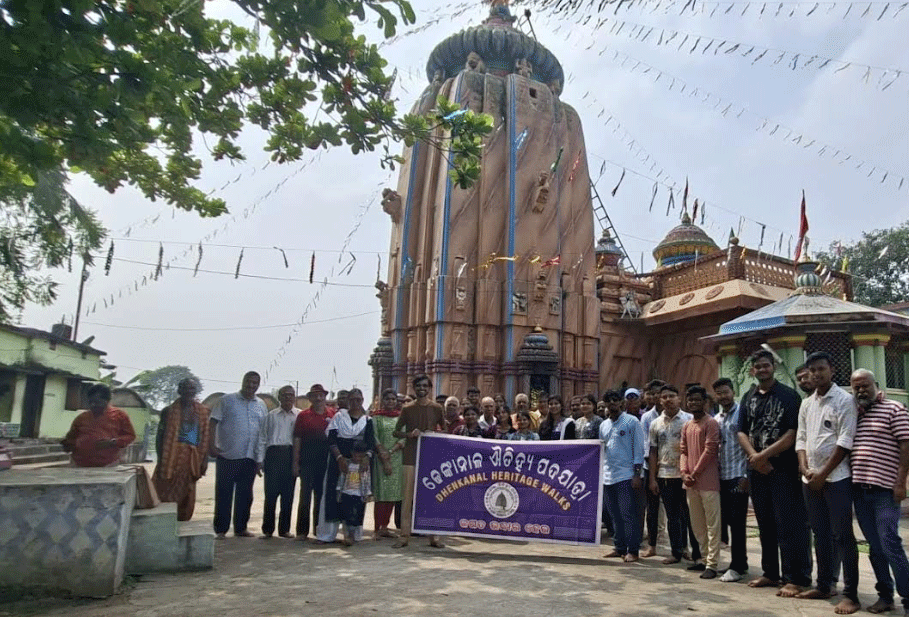Dhenkanal: Chitalpur, with a history over 1,400 years and famous for the Sthambeswari or Khambeswari shrine is not just a old village. It has a rare monument which was once a signature cult as the Sthambeswari shrine was once the presiding deity of the Sulki Dynasty of the Kodalaka Mandala (present day Dhenkanal-Anugul).
Heritage enthusiasts under the aegis of Dhenkanal Heritage Walks (DHW) last Sunday on their 30th encounter visited the 8th Century village, probably constructed by Kulastambha as his inscriptions have been found in Hindol. Chitalapur is hardly 20 km from Hindol and is only 4 km from the Sukia Bauti Temple of Kunua village.
Chitalpur is a brilliant example of this Sthambeswari cult where “10 sthambas” were erected and are still present along with a deity who has been later worshiped as the village deity. The deity also stands on a pillar which is the same as the erected pillars outside the temple.
Sthambeswari or Khambeswari is a prominent female deity who is generally represented on a pillar or stone. The cult of Sthambeswari peaked its footprints in Kodalaka Mandala between 7th Century and 10th Century. Sulki rulers were feudatories of the Bhaumakaras, but later they started ruling independently. Their empire extended up to Sankhajotisha which may be somewhere in Sundargarh near Sankha river. The rulers of this dynasty named themselves Ranastambha, Kanchanastambha, Jayastambha, Kulasambha etc with their capital at Kualo village in Parjang block. They considered Goddess Sthambeswari as their presiding deity and used to donate villages to Brahmins as evident from their Hindol, Bhairabgarh and Talcher inscriptions.
The heritage enthusiasts under the guidance of convenor Suresh Mishra of DHW also visited the Swaymbhu Ugraswar Shiva temple of the village. A copper plate found be late Bairagi Panigrahi handed over to late RP Mohapatra, which is now in Odisha Museum, was deciphered by Pandit Satyanarayanan Rajguru, which reconfirm about donation of this village to Brahmins.
Odia Novel Day was also celebrated by DHW for the first time in the State at the auditorium of Ugreswar Mahadev Peetha. Senior poet and professor Ramesh Chandra Sahu participated as the main speaker and highlighted the validity of celebrating the day today.
On October 19, 1888, the first full-length novel in Odia, “Padmamali”, was written by Umesh Chandra Sarkar, the then assistant manager of the Dhenkanal Palace, and was published in Dhenkanal, which the author said is clearly mentioned in the preface of the book.
”At a time when prose literature in Odia was not developed, the self-publishing of the first Odia novel from the land of Dhenkanal has glorified the rich history of our district,” said Tapan Kumar Shatpathy, a retired government official and culture and history researcher, who attended as the chief guest.
”Dhenkanal district, the land of ‘saraswat sadhana’ (creative writing), has provided many important innovations in the entire state in the past in many fields and Umesh Chandra Sarkar was one of the pioneers of that innovation,” said Dibakar Panigrahi, president of Chitalapur Village Committee, who attended as the guest of honor. Joining as another guest, Durga Charan thanked the DHW for this initiative.
On this occasion, the guests released the book “Hrudyara Swar” written by poet Kiran Panigrahi. Founder member of DHW, Malay Ranjan Pati was felicitated. Chitalapur’s Anandhi Purav Sangh supported the event in which many locals and 35 members and students of Dhenkanal College. Finally, Prabhanjan Panigrahi, secretary of Parameswar Yuvak Sangh, thanked the visitors. Biswaranjan Dehury of Odisha Heritage Walks said a series of books on heritage villages of Dhenkanal should be documented.


